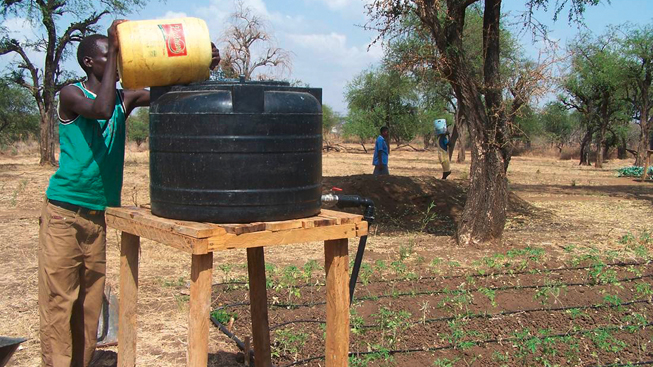Cauliflower, broccoli, sweet pepper and many other nutritious vegetables used to be expensive in Mauritius. The island's climate and traditional agricultural practices were not suitable for cultivating several high value vegetable crops, while importing them to the island state was prohibitively costly due to the long distances involved.
This has all changed over the past few years, and local farms are now starting to supply the country's growing population and burgeoning tourism industry with fresh, locally grown produce.
The trick: drip irrigation, which was made possible with the help of nuclear techniques that can measure moisture levels in both the soil and the plants, enabling farmers and agricultural officers to work out exactly how much water and nutrients to use and when (see Nitrogen isotopes in soil management).
"The adoption of drip irrigation has increased food crop production and the revenues of farmers across the island," said Ram Vencatasamy, the research scientist in charge of the irrigation programme at the Mauritian Food and Agricultural Research and Extension Institute (FAREI).
"Drip irrigation is a very good system for us small-scale farmers," said Manoj Chumroo, a farmer from eastern Mauritius, who has been growing vegetables with his wife on their 1200-acre plot since 1986. "It can really help increase our yield and income."
Drip irrigation allows water to be fed to the plants through a network of pipes or narrow tubes that deliver water directly to either the base or the root. The process helps to reduce water use.
"I doubled my crop yield this season," Chumroo said. "And the vegetable auctioneers have paid good market prices because of the premium quality of the cauliflower and chilli."
As a result, Chumroo has replaced his bicycle with a motorcycle for his morning drive to the fields. He has bought an adjacent plot of land and has taken out a bank loan to introduce drip irrigation there as well. He has also completed the construction of his house and has bought additional furniture. "Once in a while, I can even take my family to dinner out in a restaurant," he said.
Almost 80 per cent of the total cultivated area in Mauritius is rain-fed. With limited financial resources to invest in expensive sprinkler systems or irrigation dams, farmers like Chumroo used to carry water in cans, a process that is both labour-intensive and wasteful. To make matters worse, said Vencatasamy, there has been a noticeable decrease in annual rainfall in Mauritius over the past 10 years, lowering crop yield and the productivity of small-scale farmers.
Agriculture already accounts for 70 per cent of global freshwater use. By 2050, global water requirements for agriculture are expected to grow another 50 per cent to meet demands of a growing population, according to the Food and Agriculture Organization of the United Nations (FAO). Improving water efficiency is crucial for sustainable development.
"Fertigation": Water-fertilizer combo
To further optimize crop yields, and conserve resources, farmers increasingly apply a technique that provides the plants with fertilizers mixed with water, a process known as fertigation. Fertilizer using an isotope of nitrogen is applied to a small plot of land through fertigation to determine the efficiency of fertilizer and water uptake by the plants and to optimize the amounts required, explained Lee Kheng Heng, Head of the Soil and Water Management and Crop Nutrition Section at the Joint FAO/IAEA Division of Nuclear Techniques in Food and Agriculture. The technique can save up to half of the fertilizer traditionally used to achieve the same results, she said.

Drip irrigation in Kenya. (Photo: L. Heng/IAEA)
"Scaling back on fertilizer helps to protect people and the environment against pollution as there is less chance of residual fertilizer seeping into the groundwater or polluting nearby streams and rivers," Heng said. The IAEA has made the technique available to agriculture officers and farmers participating in 19 drip irrigation projects across Africa.
Results include:
- Kenya: Development of a low-cost, smallscale drip irrigation system that generated 2.8 times the yield of field grown tomatoes while using only 45% of the water traditionally applied by hand.
- Tanzania: The use of drip irrigation provided a tea yield four times higher than that of the rain-fed, non-irrigated tea.
- Sudan: Drip irrigation saved irrigation water by 60% and increased the yield of onions by 40% compared to surface irrigation. The system is now adopted by farmers in many villages north and south of Kassala in eastern Sudan.
